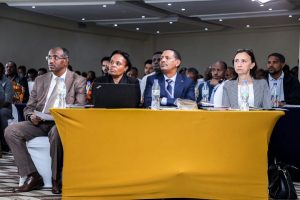BY DARGIE KAHSAY
Following the successful plantation of five billion trees during the 2020 greenery campaign, Ethiopia announced to supply six billion seedlings, five billion to be planted at home and the rest one billion seedlings to be distributed among neighboring countries.
Ethiopia’s greenery initiative, started in 2019 by planting over four billion trees in one rainy season is now becoming a serious national agenda. According to Environment, Forest and Climate Change Commission (EEC), the planting performance of the two years, 2019 and 2020 was 118.9 per cent from the national plan.
EEC disclosed that during the two years, Ethiopia plans to plant nine billion seedlings and planted 10.7 billion. Now, to make the seedling plantation a regional culture, Ethiopia plans to supply six billion seedlings, one billion to distribute to all its neighbors.
During its 2020 greenery program performance evaluation and 2021 action plan preparation discussion, EEC disclosed that from the 5.9 billion seedlings planted last rainy season, over 3.2 billion plants got caring and protection up to now.
According to the commission, during the 2019 plantation campaign over 23 million people and during the 2020 plantation period over 27 million Ethiopians have participated in the plantation.
Learning from these experiences of the past two consecutive years, for the proper plantation of the 2021 greenery campaign preparations are already started and the preparation divided into three categories, according to the Commission. The 2021 seedling preparation is divided by rural, urban and neighboring countries seedling preparation.
EEC Commissioner Professor Fekadu Beyene told the media that during the previous plantation periods, Ethiopia focuses on foreign trees, but during the 2021 plantation it gives due attention for development of indigenous trees.
According to the commissioner from the five billion seedlings planned to be planted in the 2021 greenery program, 67 per cent is tree for forest coverage. From the total trees planned to be planted during the 2021 seedling plantation, 35 per cent would be indigenous trees.
According to the action plan of the commission for the next seedling preparation and plantation, it needs 800 thousand hectares to be prepared and to cover by the plantation at home.
In addition, it needs over 100 thousand nursery sites to prepare the six billion seedlings and the commission is working with its respective institutions and lower structures for the proper preparation of the seedlings.
The commission also specifically divides the one billion seedlings planned to be distributed to six Ethiopian neighbors basically considering the basins which Ethiopia shares with its neighbors.
According to the Commission, it plans to distribute 91 million to South Sudan, 356 million to Sudan, 29 million to Eritrea, nine million seedlings to Djibouti. It also plans 129 million to Somalia and 386 million seedlings to Kenya.
Professor Fekadu stated that to produce proper seedlings suitable for each Ethiopia’s neighbor scientifically, EEC is working with Forest Research Institute, Higher Educations and with regional states.
He said that the commission has signed memorandum of understandings with eight Ethiopian Universities and six regional states, to produce the one billion seedlings planned to distribute to neighboring countries scientifically.
Even locally, to develop the sector, it needs leaving the traditional way of plantation and investing on knowledge based actions. Hence, the commissioner stated, to boost the forest coverage of the country scientifically, Ethiopia is implementing knowledge based forest development by introducing technologies to the sector.
EEC’s 2018 forest coverage inventory indicated that Ethiopia’s forest coverage was only 15 per cent, Commissioner Fekadu said. Taking this as the base line, Ethiopia launched the 2019 plantation initiative to develop its forest coverage to 30 per cent by 2030.
He added that, it successfully implemented the first two years of the plantation program by planting over nine billion trees and the level of survival of the planted seedlings is very appreciable.
According to the commission, the current plantation focuses on forest, collective agriculture and frits mainly to develop the forest for development including commercialization and food security.
For 2021, necessary preparations are already ongoing properly in land preparation, nursery preparations, distribution and collection of seedling seed and identifying the type of seedlings suitable for the different areas and their weather condition.
Meanwhile, Forest Development Director at Oromia Bureau of Agriculture and Natural Resource, Sileshi Lemma told The Ethiopian Herald that Oromia is preparing for the coming plantation program.
Sileshi said that Oromia Regional State has planted over 5.2 billion seedlings during the 2019 and 2020 seedling plantation periods. He added that for the national goal of next plantation and forest coverage target, the past two consecutives plantation programs has laid down a base.
According to the director, Oromia has planned to supply 4.1 billion seedlings for the coming plantation program and preparations are going well in experts training, nursery and land preparation and selection of areas for the plantation.
“To produce the 4.1 billion seedlings currently more than 24 thousand nurseries have already started their activities in Oromia and in the coming two months we plan to finalize all necessary activities” he said.
1801 quintals of seed is already at hand which covers over 74 percent of the required amount to produce 4.11 billion seedlings, according to the director. Tree planting in Oromia focuses on urban beautification, forest coverage and developing commercial trees.
Environment, Forest and Climate Change Authority’s Director at Southern Nations, Nationalities and Peoples’ Region (SNNPR) Samuel Kekebo on his part told The Ethiopian Herald that the region is scoring significant outcomes in boosting forest coverage of the region in recent years.
For Samuel, in 2014, SNNPR forest coverage was 19 percent. But now, with tieless efforts of consecutive plantation and protection of the available forest areas, the forest coverage currently develops to 23 per cent.
Samuel stated that by increasing 0.7 percent forest coverage with mass plantation yearly, the region plans to develop the total forest coverage of the region to 30 percent by 2030.
As part of the national greenery initiative and to meet the goal of the region forest coverage, it plans to supply 1.5 billion seedlings, of which 1.36 to plant in the region and the remaining supplied seedlings to contribute the national agenda of distributing to neighboring countries.
Both Oromia and SNNPR announced that they are working with EEC to produce the seedlings foe neighboring countries scientifically by identifying the suitable trees for the countries they can share. In addition, even in their regions, they identify the type of tree for each area to boost the survival rate of the planted trees.
Amhara State Agriculture Bureau Deputy Head, Markos Wolde on his part stated that the region plans to supply over 2.47 billion seedlings for 2021 plantation. He added that in 2020, the region has planted over 1.59 billion seedlings and over 83.2 percent of the planted trees got protection and caring.
According to Markos the region focuses on plantation of commercial tress like bamboo and avocado. He pointed out that seedling plantation and protection of dense forest is now becoming part of nation building.
The Ethiopian herald January 1/2021





